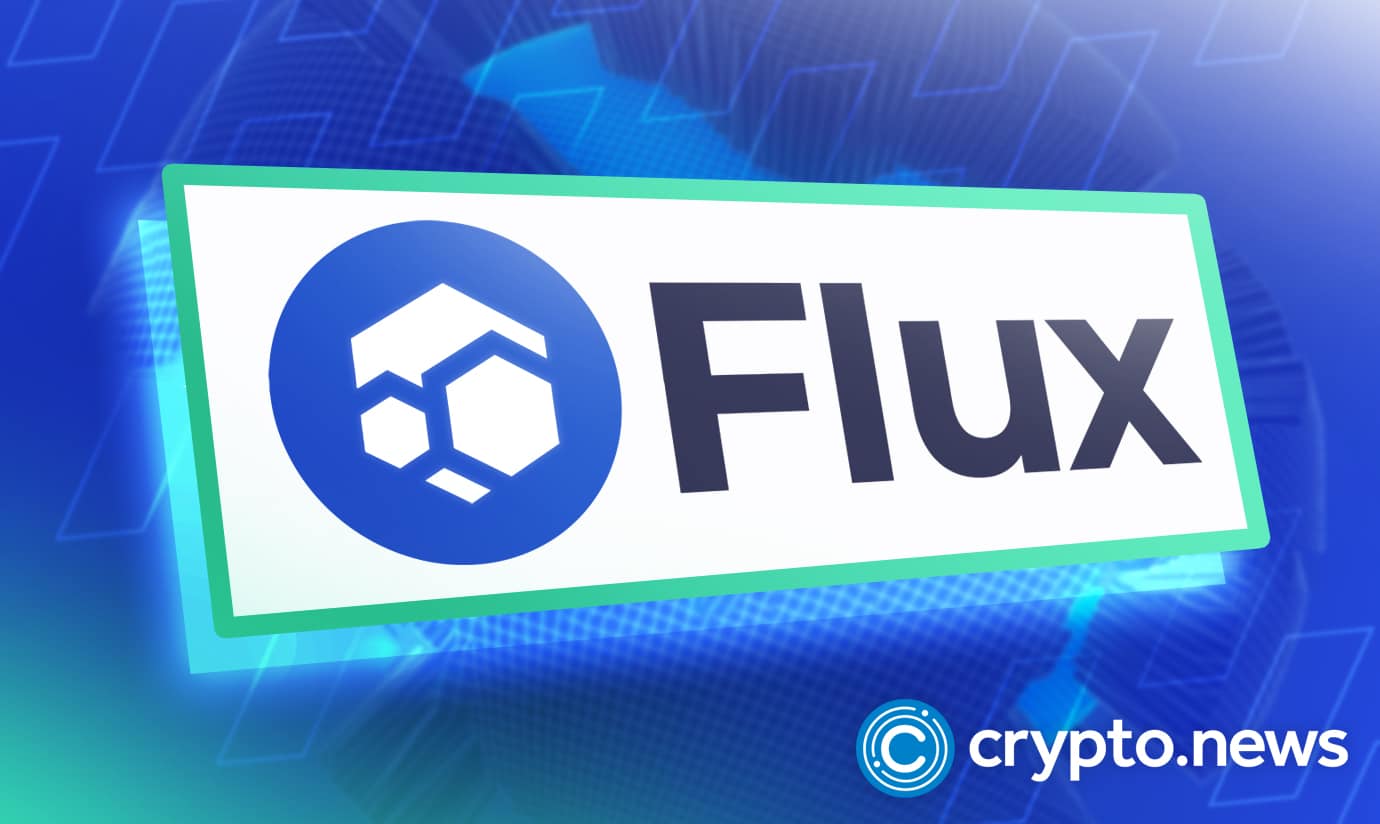FLUX Decentralized Network- What Is It and Why Does It Matter?

There are a lot of innovations in the space of crypto, web3, and other digital media. Some of these innovations focus on improving the blockchain while some are trying to take on the role of the “Ethereum killer.” Meanwhile, Flux, a top company in the tech innovation space, is focused on bringing enterprise-ready solutions to the market. This network is built as a parallel but not an Ethereum Killer. Let’s learn more about it.
What Is Flux Network?
The project, initially called ZelCash, has made numerous significant advancements since it was launched in 2018. However, in March 2021, it was renamed to reflect the project’s new name, Flux. This change was regarded as a significant step in the project’s roadmap.
The platform, the Flux ecosystem, consists of a suite of computing services and a blockchain as a service. It enables end-users and developers to create and manage applications on Web3. In addition, it offers a variety of environment development systems that developers can use to transition applications to Web3 seamlessly.
The FLUX ecosystem comprises various components, such as the FLUX blockchain, the operating network, and the platform’s native app, the FluxOS. It also hosts a multi-asset crypto wallet, ZelCore. Additionally, it has its DAO, XDAO.
Developers can easily create and manage decentralized applications (dApps) on the FLUX ecosystem. It allows them to take advantage of its various features, such as its flexible design. In addition, it offers a grant scheme that will enable developers to receive funding for their projects. The platform’s developer toolkit also provides a minimal development environment.
As a public blockchain, anyone can contribute and interact with the network of the FLUX ecosystem. For instance, users can build or interact with dApps without requiring permission. They can also run network nodes or mining to contribute to the ecosystem.
What Problems Does Flux Network (FLUX) Solve?
FLUX was developed to solve the following issues;
Centralization
One of the main problems confronting the blockchain industry is centralization, which is addressed by the Flux Network (FLUX). Any point of centralization in a decentralized environment results in a weak link in the network. Oracles are one application where centralization has shown to be a genuine problem.
Off-chain sensors, the oracles, send and receive data from the blockchain. These are considered some of the fastest-growing parts of the blockchain tech industry due to their ability to provide various services and features. Unfortunately, these systems are generally flawed due to their centralized nature.
Through a combination of decentralization and security, Flux can improve the performance of its users’ oracle data streams. It also eliminates the need for a group to monitor and confiscate transactions. This technical structure makes it incredibly resilient to system failures.
Lack of Scalability
The Flux network aims to provide a scalable platform for high-performance applications. Its flexible architecture allows it to support various types of smart contracts.
Confusion
Another issue the protocol solves is that it eliminates the need for new users to navigate through complicated features. It allows developers to build a secure and efficient cloud infrastructure. Another advantage of the system is that it allows users to retain their original blockchain.
The FLUX Token
The native asset of the FLUX ecosystem is the “FLUX.” It is used to maintain the operations of the various leading chains in the network. As the central component of the ecosystem, it is essential to the smooth running of the cryptocurrency project.
As a multi-utility asset, it is responsible for collateralizing and incentivizing the various FluxNodes. It also facilitates the exchange of transactions within the network. FLUX’s decentralized two-factor authentication system allows users to perform transactions without requiring a third party.
Through its user-centric approach, FLUX aims to reward its users for their contributions to the project. Unlike other projects, which have started to implement an initial coin offering, the project does not have an ICO. That ensures that the most prominent contributors get the biggest rewards.
Unlike Bitcoin, FLUX utilizes a Proof-of-work (PoW) algorithm instead of a consensus. It utilizes its hashing algorithm known as FluxHash. At the time of writing, each valid block of the network has produced 75 FLUX.
The rewards distributed by the blockchain are divided equally between the various members of the network, namely the PoW miners and the FLUXNodes. Similar to how Bitcoin works, the block rewards on the FLUX blockchain will halve every two years. That increases the demand and scarcity of the asset.
The total supply of FLUX is expected to reach 440 million. It is a significant increase from the previous 123 million supply. During the hard fork update of the project, developers converted all ZEL coins to FLUX in a 1:1 ratio.
The existence of parallel assets partially compensates for the increased supply of FLUX. Although the total supply of FLUX and its parallel assets can only reach 440 million, the distribution of these assets can vary depending on the network’s leading chains.
Exploring the Flux Ecosystem
The concept of the Flux network is a combination of various parties and protocols working together. As a pioneering project in the field of Web3 technology, the ecosystem is responsible for hosting and managing multiple nodes and miners.
The ecosystem is also responsible for running the computational network known as the FluxOS. This platform allows developers to create applications easily. In addition, the ZelCore multi-utility platform is a part of the ecosystem. This article aims to provide a deeper understanding of the various aspects of the network and its ecosystem.
FluxOS
The network’s core is FluxOS, a distributed chain-agnostic system that enables developers to build decentralized applications. As a fully open-source protocol, it guarantees that their applications will be operational and live at all times.
The various nodes within the network, known as FluxNodes, are responsible for powering the applications and the network. If one or more of these nodes goes offline, the activities and operations of the applications on the network would not be affected.
Developers can easily run their applications on any blockchain using the open-source FluxOS platform. Moreover, using “dockerization” allows them to deploy applications without developers having to learn new programming languages.
Developers can easily create and manage decentralized applications using the platform’s application programming interface (API) and user interface(UI). With the help of this, they can seamlessly transition their applications to the Web3 internet. Unlike other platforms, which require a lot of backend work, the user interface, and API of the FluxOS platform allows developers to focus on the frontend aspects of their dApps.
The FluxOS architecture takes advantage of the most recent open-source JavaScript software stack while running on infrastructure that employs the MEVN stack (MongoDB, Express.js, Vue.js, Node.js). FluxOS, meanwhile, claims a broad range of use cases. That covers blockchain as a service (BaaS), which could involve hosting nodes or applications. Additionally, FluxOS enables programmers to create oracles that gather distributed data sets. FluxOS also makes it easy for developers to install web servers and blockchain games.
On the FluxOS platform, users may vote in the Flux network’s decentralized autonomous organization (DAO), connect with global apps, and examine resources and incentives.
FluxNodes
In open-source projects, the members of the community who run a FluxNode are responsible for maintaining and maintaining the network of the company’s operating system, known as FluxOS. However, running a high-end hardware platform such as a FluxNode requires a high uptime guarantee.
As part of the incentives for securing the network, there are various requirements that one must meet to become a FluxNode. These include the type of node one wants to operate and the security measures required to maintain the network. That allows the community members to provide computational resources to the system.
Although FluxNodes come in three levels, they all use the cutting-edge proof-of-work (PoW) hashing algorithm “FluxHash” (also known as “ZELHASH Equihash 125,4”). Other “Equihash algorithms from ZCash(200,9) and ZHash(144,5)” are combined to create FluxHash.
The outcome is a system resistant to application-specific integrated circuits (ASICs). As a result, GPU miners are more likely to use Flux, which allows for an equal mining pool with no danger of decentralization.
FLUX asset holders can run various types of nodes depending on their requirements. These include the three main types of nodes: the Cumulus, the Nimbus, and the Stratus. The lowest requirements are that the Cumulus has a minimum of 2 vCore, 4 GB RAM, and 50 GB of HDD/SSD hardware. In return, the nodes can receive 7.5% (or 5.625 FLUX) of the total FLUX block rewards.
Nimbus FluxNodes demand more hardware and collateral in exchange for a higher deterministic block reward of 12.5%. (or 9.375 FLUX tokens). The requirements are even greater for Stratus FluxNodes. Users must collateralize at least 100,000 FLUX tokens in addition to running hardware with at least 8 vCore and 32 GB RAM. Stratus FluxNodes are compensated with 22.5 FLUX tokens every block or 30% of the FLUX block rewards.
ZelCore
ZelCore is a leading decentralized application (dApp) currently operating on the FluxOS platform. It features a multi-utility blockchain and a crypto wallet. Through its platform, users can store over 380 different cryptocurrencies.
As a free app, users can easily swap their existing fiat money for different types of cryptocurrencies. They can also buy crypto with a debit card. In addition, ZelCore features a two-factor authentication process known as d2FA as Flux’s Network’s designated multi-asset portfolio management platform.
FLUX token holders can pay for premium features through ZelCore+, a subscription service that offers a variety of exclusive features. These include portfolio tracking, access to API integrations with major exchanges such as Kraken and Binance, and additional wallets for each asset.
Through ZelCore+, users can easily access and trade on major exchanges. It also features an aggregation feed of project and industry news and syncs their exchange accounts. In addition, users can import private keys into their ZelCore lite wallets.
Users can use the ZelCore platform to access various applications, such as the Fusion app. This app allows users to easily transfer their FLUX coins and tokens between the various blockchains.
The Fusion app allows users to distribute the FLUX token’s rewards and parallel assets. ZelCore is a decentralized app that users can use on desktop and mobile devices. Users can access it on all operating systems, including Windows, Linux, macOS, Android, and iOS.
XDAO
The project’s governance, which aims to establish a decentralized internet and a Flux network, lies with the members of the Flux governance(XDAO). To become a member of the DAO, one must have a certain amount of FLUX tokens.
To view the activities of the project’s governance committee, users can access its main website, runonflux.io. They can also view the network’s open, passed, and rejected proposals. Details about the votes, such as the end date, number of ballots required, and the submission date, are publicly available.
GPU Miners
Half of the block rewards (37.5 FLUX) go to the GPU miners. These individuals are responsible for processing and validating transactions in the ecosystem. Doing so helps provide the computational resources needed to run the network.
Miners of the Flux network can participate in various mining pools. These pools are created by third-party teams and are supported by the community. Each pool has unique restrictions, such as the type of nodes it accepts and its geographic location. Some current mining pools available for the community include the NLPool, the Flux Community Pool, the Solo Pool, and the Zergpool.
Parallel Mining
FLUX is available on the blockchains of various popular cryptocurrencies. The assets mined using the platform are technically coins, while those owned by other blockchains are tokens.
The FLUX network features a parallel mining system that allows anyone to mine the platform’s assets on different chains. FLUX tokens are fully interchangeable with the main chain’s assets at a 1:1 ratio. To enable this, users can access the Fusion app, which is available through the ZelCore wallet.
The main reason why FLUX can operate on multiple blockchains is that its decentralized finance platform allows users to access multiple different types of platforms.
The network of FLUX aims to develop ten parallel assets on other chains. Currently, five different chains are actively working on integrating FLUX token compatibility. These include Ethereum, Binance, Kadena, Solana, and Tron. The remaining five are yet to be announced.
Coming Developments and Future Potential for Miners
With the release of Flux, many exciting developments are happening in the world of mining. One main factor that sets it apart from other projects is its developer resources.
More parallel assets are being deployed in the short term, and the next drop will be called FLUX-ERGO in October 2022. That will allow for the continued distribution of more assets, increasing the project’s profitability. In addition, the company is working on improving its mining efficiency.
In the long run, the company is working on developing a new proof of work model called PoUW, which will allow miners to solve various computational tasks. This new mining algorithm will enable them to solve real-world problems such as rendering, training AI, and other computational work.
Using PoW, mining rigs can switch between “normal” mining and solving PoUW jobs, which are more profitable. That will help improve miners’ profitability and make the project more sustainable.
Jeremy Anderson is the lead developer of PoUW. He previously worked on projects such as PIVX, Ravencoin, and Veil. The company was able to develop the technology through collaboration with a university in Switzerland.
PoUW: A Game Changer for Proof of Work and Blockchain
Despite the success of Proof of Work, there is still room for improvement. Enter PoUW.
PoUW is a new computational resource that can be utilized for various purposes. Unlike mining, it requires a high-security level to operate. That means that it is energy-intensive to perform. Members of a blockchain network are required to solve a random cryptographic puzzle to maintain the system’s integrity.
The typical approach to solving this puzzle involves using a brute-force method. Unfortunately, this method consumes a lot of GPU resources to perform. Instead, the energy is used to generate the hash or solution.
What if, instead of mining, these resources could be used to solve real-world problems that provide value to society? Miners can get more purpose and reward through the Proof of Useful Work platform.
Some of the areas that PoUW can be deployed to grow performance and efficiency include:
Deepfake Detection
The rise of Deepfakes in 2017 was largely due to the advancements in AI and the increasing number of tools that allow users to create videos with distorted or altered voices and faces. Due to the nature of these tools, they are becoming more dangerous. PoUW has the necessary resources to help identify and prevent these false scenarios.
Research
Mass amounts of computational power are needed to solve various computational problems, such as those related to the study of protein folding. With the help of PoUW, researchers can use the power of hash-power to solve these problems. In addition, it can help predict the weather and track climate conditions.
Training Machine Learning Models
Due to the high amount of data sets and power required for ML algorithm training, such as computer vision and reinforcement learning, it can be very challenging to perform these tasks on a personal computer. With the help of PoUW, researchers can now take advantage of the immense resources of miners’ hardware to solve these problems faster, cheaper, and more efficiently.
Benefits of Flux Network (FLUX)
Aside from being able to provide a variety of blockchain solutions and services, this network also allows developers to create decentralized applications. That can help them reduce their time and errors while improving their platform. In addition, it offers users an efficient base layer.
Passive Rewards
The FLUX Network allows users to earn passive rewards through mining or node operations. They can do these activities through the use of FLUX tokens. There are two types of nodes on the blockchain: miners and nodes.
Miners perform transactions on the blockchain while nodes execute smart contracts. The network distributes block rewards evenly between both GPU miners and nodes.
Compared to other platforms such as Bitcoin and Ethereum, FLUX is easier to mine. It only requires three gigabytes of RAM to run. The number of nodes has also significantly increased recently.
Interoperability
Interoperability is a vital component of the DeFi ecosystem, as it allows developers to easily create and manage applications that are compatible with different networks. It also helps improve technology adoption by enabling them to access more networks.
Developer Support
Developers can easily create a variety of dApps using the FLUX platform. The developers are also encouraging third parties to contribute to the ecosystem. Furthermore, the platform’s features can be integrated with other blockchain applications, making it easier to launch new programs.
The Flux Ecosystem Vision of tthe Future
The ecosystem of the Flux Network has seen continuous development since it was first deployed in 2018. The team behind it has been focused on developing a working product instead of marketing an unfinished one.
The project is live and operational, and it is open-source. There are also weekly updates on the development of the platform. The roadmap for the project has been designed to consolidate the various milestones.
Currently, the Flux Network is working on a second snapshot, Proof of Useful Work – Proof of concept roadmap, and further application development controls. Furthermore, they are looking to achieve persistent storage release beta, dApp resource monitoring, and jetpack, two tools, and metrics, by the end of 2022.
Final Thoughts
The developers of the Flux Network took the necessary steps to ensure that the information entered on a blockchain was correct. That is because if the information is not entered correctly, it could cause issues with the system. With that in mind, the network eliminates the problems caused by centralized oracles. It’s hence expected that the platform will continue to see continued adoption.













